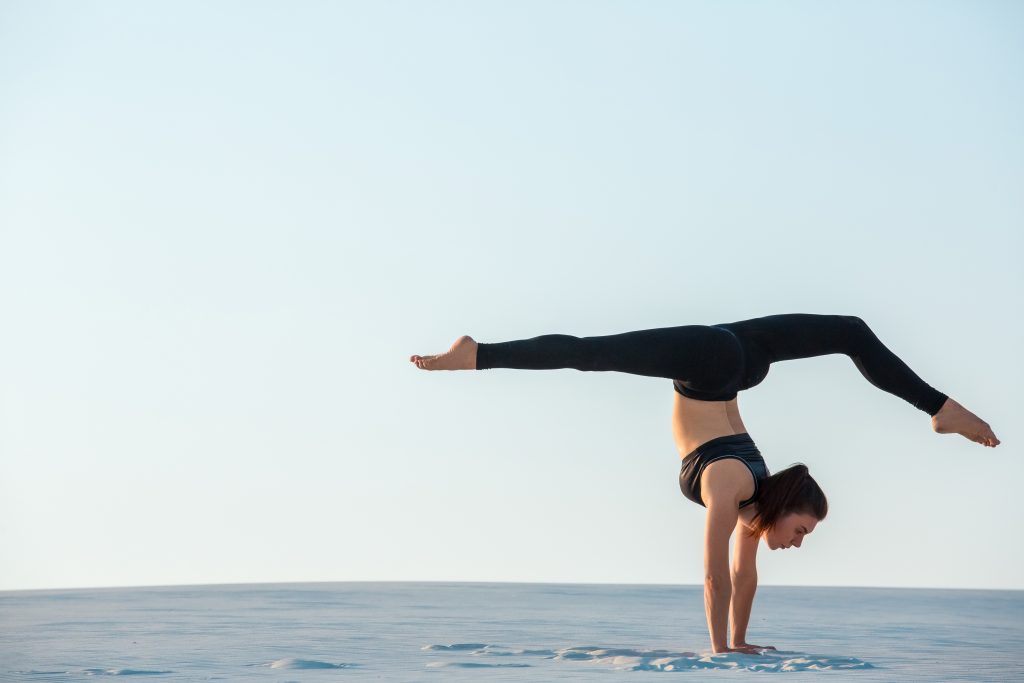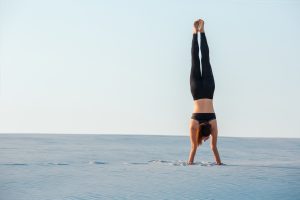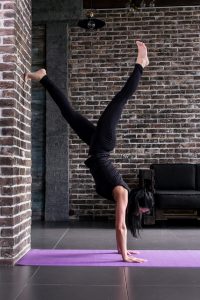Gymnastics based training is becoming increasingly popular in today’s gym and fitness industry. More and more people are looking to learn how to handstand. The current boom of CrossFit is influential, and many people are aiming to develop core components of gymnastics to supplement their training. There are many benefits to learning how to handstand, such as body-awareness, core strength, and kinetic chain alignment. It also makes a brilliant party trick!
How to Handstand: What Does the Perfect Handstand Look Like?
There are three essentials in developing a well-formed handstand. I see too many people doing handstands with poor form. When they then progress to do different handstand shapes or attempt one arm handstands, they seem to struggle with holding them. This is purely down to bad form and/or technique. I have three tips when doing a handstand;
1. Push Out of Shoulders
When learning how to handstand, this is often overlooked. You should not relax your shoulders at any point. If you do so, this will allow the shoulders to sink, and you will lose your form. You need to keep your shoulders in a constant shrug position, and this will ensure your body is in alignment.
2. Point Your Toes
Ensure when you kick up to your handstand you point your toes straight away. You should feel tension throughout your lower limbs because you should be squeezing through your legs down to your toes. This will really help you in learning how to handstand. It aids your balance and also helps to align you with your kinetic chain. If drilled enough, this will become a habit. It is crucial to get this right from the start, as you should eventually be able to do it without even thinking about it.
3. Squeeze Your Core
When squeezing your core, you should feel your abdominals working hard. People assume that your core is solely made up of your abs, but it is also made up of many other muscles. Your back extensors (erector spinae and multifidus) act as a big part of it as well as your obliques. You should think about squeezing the core as a whole. In this way, learning how to handstand goes alongside learning how to engage all of your core muscles.
How to Handstand: Common Mistakes
Many people let their shoulders sink when they kick up into a handstand. This pushes the weight back onto the palm of your hand and results in loss of balance. You actually use your fingers to control your balance. If you’re unsteady in your handstand, squeezing your fingers can bring you back into balance. Pointing your toes in a handstand helps to engage your lower limbs and help to align your kinetic chain to one smooth line.
Many people will allow their back to bend when they are doing a handstand because they aren’t engaging their core. This is something gymnasts term ‘banana back’. If your back is bending like a banana when you’re learning how to handstand, think about pointed toes. If you develop a habit of bending your back, you may be able to handstand, but you won’t be able to hold it for very long. You also won’t be able to progress further with learning how to handstand in other shapes.
How to Handstand: Conditioning the Body for a Handstand
When looking at the perfect handstand, you want to ensure that your body is one straight line. This doesn’t just come down to practice. It involves breaking the handstand down into certain essential concepts.
Strength and flexibility are both integral to this. If you do not have significant power in your shoulders, your body will not be able to hold you. This will either result in you being unable to maintain a handstand or making other parts of your body compensate for lack of shoulder strength. To improve shoulder strength, I would recommend doing some press-ups. Try three to five sets of 12 if you can manage them, as we are looking at building strength.
You need to have a reasonable amount of flexibility in your shoulders and wrists. Both of these get pushed to the extremes when holding a handstand. A great way to stretch out your shoulders is getting them into extension. You can do this with the facilitation of a wall or the floor. Hold the stretch for 30 seconds and repeat this every day. You should be able to push yourself that little bit further each time.
Strength is key!
Having core strength is essential in developing a proper handstand. So, before you move onto handstands, you need to ensure your core is strong. Exercises such as v-ups will help develop the strength you need in your core to hold a handstand. To learn more about v-ups here’s a demonstration clip.
You may also need to strengthen your back to stop you from going ‘floppy’ in your handstand. For me, there is nothing worse than seeing a banana-shaped handstand. Regardless of whether you can hold your handstand for long or not, your form is everything. Try some dorsal raises to strengthen your back extensors and stay away from that nasty banana shape. Here’s a video showing how to correctly perform dorsal raises.
How to Handstand: Handstand progressions
Everyone believes that when learning how to handstand, you need to start by doing handstands against a wall. Although this can help you to perfect your form, it doesn’t actually prepare you for the balance element of the handstand as you become very reliant on leaning on the wall.
I recommend starting in a press-up position facing away from the wall. You then want to walk your feet back and then walk them up the wall slightly. This helps your body get used to putting weight through the shoulders and wrists. As you start to get better at this, you can gradually walk your legs higher up the wall until you’re in a straight position. This will really begin to challenge your balance and also your core strength. You should be aiming to push entirely out of your shoulders, with your nose close enough to the wall to touch it. This will be how you know that your body is wholly in line. You should be squeezing your core throughout this.
How To Handstand: Benefits of Learning to Handstand
Handstands aren’t just fun and a great challenge. They also incorporate many essential fitness elements including strength, balance and coordination. They can also provide a fun alternative to change up your workout plan. You also don’t need any specific equipment. You can practice these at home, the gym or even in the local park. The possibilities are endless.
Strength
Handstands improve strength in your shoulders and wrists but also the body as a whole. This, in turn, can then help you with increased upper body strength as well as a better posture. It also leads to more definition in your shoulders and back, and stronger core muscles, helping you with other exercises.
Balance
Balance in handstands is developed through practice. Benefits of increasing your balance include better proprioception for sports, better spatial awareness and decreased risk of injury. You’re less likely to fall over or trip if your balance is in check.
Coordination
Improvement in coordination helps with most things in day to day life. Coordination helps you to move fluently ensuring your body moves as one. This can help improve your motor skills with more precision and accuracy of movement.
Having been an acrobatic gymnast for many years, I spent my whole life balancing on my hands. I used to balance on people’s hands as part of my discipline so having a solid handstand was essential. One thing I used to struggle with was my form. Before I began a core programme, I could hold a handstand for ages but had un-pointed toes and ‘banana back’. When it then came to learn different handstand shapes, I always wondered why I wasn’t able to either get in the position I needed to be or to hold it for very long. This was because my core was under-conditioned and I didn’t have the strength to pull my tummy back under into a straight position. After working my core programme, the improvements were amazing.
I can now hold a handstand for a long time because I have practised so much. As soon as I nailed my general two-hand straight handstand, I was very keen to learn other shapes. I can now do a variety of handstand shapes on either both hands or one.
Once I’ve Mastered the Handstand How Can I Progress?
When you nail the basics of how to handstand there are many progressions you can do to challenge yourself. One of them is handstand walking. This will test your dynamic balance as you are required to move your hands at the same time as maintaining your balance. Make sure you have adequate space, squeeze and remember all the points form the basic handstand. When you start to move, do not rush as you will lose form. Take your time and remember to breathe!
So, you’ve mastered the handstand walk, and you want to progress your strength further? This can be done by learning ‘headstand push to handstands’. Start of firstly by using the wall to help with your balance, or you can ask a friend to support your legs. You can start off by tucking your legs down, and as you straighten them, your arms straighten at the same time. This is the most basic level, but this is still hard. You can then eventually progress to doing them multiple in a row with straight legs. This will build strength in your shoulders and help with stability in your handstands.
There are so many progressions with handstands. I could write 10,000 words on the various handstand shapes alone. Handstands can be very specialist areas and some people even handstand for a living. Have fun practising!




